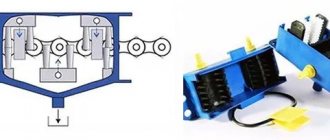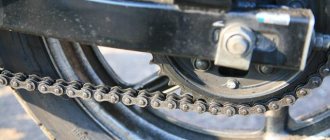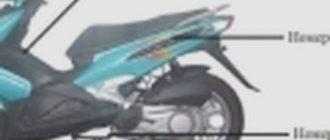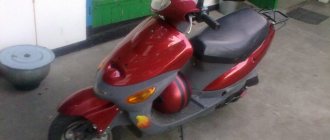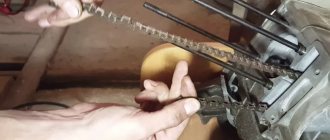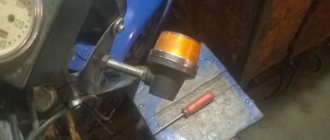- Every motorcycle has two sprockets, or sprockets, as they are usually called: The front sprocket on a motorcycle is installed on the splines of the secondary shaft of the motorcycle gearbox, from the outside, usually on the left side of the engine, and is covered with a protective cover
- The rear sprocket is installed on the rear wheel hub.
Online program for calculating the chain length when replacing motorcycle sprockets with non-standard ones.
The program, as before, can be easily downloaded here and taken with you on a trip to places where there is no Internet. If you have the Internet, it is of course easier to use an online program to calculate the chain length here on this page. This program is suitable for all types of motorcycles. Its advantage is that even in the most remote wilds of our homeland, if problems arise with the chain, you can try to find analogues of the chain from Soviet motorcycles, which are still very common. We’ll talk separately about the interchangeability of motorcycle chains of different brands later.
First, how to use the program .
In the first four windows we drive in the original chain pitch, the number of teeth of the driving and driven chain, and the number of links in the original. All this information should be found in the manual for your motorcycle. For a Honda cb400 motorcycle on an NC-39 frame, the values will look like this: Original chain pitch: 525 Number of teeth for the drive sprocket: 14 Number of teeth for the driven chain: 44 Original chain length: 108
Then we drive in those values, chains and stars that are being replaced. Let's say we put a driven star on the same sibishka, which is 1 tooth larger. Then we need to enter the following values: Chain pitch (replacement): 525 Number of drive sprocket teeth (replacement): 14 Number of driven sprocket teeth (replacement): 45
We get the length of the new chain to be 109 links. This does not happen, so we round up to 110 units. We always round up to the nearest even number of chain links.
The program automatically changes the maximum speed of the motorcycle when replacing the sprockets with non-standard ones. The general rule is this: the larger the rear (driven) sprocket, the lower the maximum speed, the larger the front (drive) sprocket, the higher the maximum speed. And vice versa.
Several parameters for selecting stars for a motorcycle:
First, sprockets are measured by the number of teeth.
Increasing or decreasing the number of teeth gives a higher maximum speed and lower acceleration dynamics. Once you know the number of teeth on your motorcycle's sprocket, you can determine a reference number called a "gear ratio" that will tell you exactly what's going on with your motorcycle's drivetrain.
You get the gear ratio by dividing the number of teeth on the rear sprocket by the number of teeth on the countershaft sprocket.
For example, a 49-tooth rear sprocket is divided into a 13-tooth countershaft sprocket, resulting in a 3.77 gear ratio for this gear combination.
This is how many times the intermediate shaft sprocket rotates before the rear wheel makes one full revolution.
Choosing the right gear ratio is a great, inexpensive way to make your motorcycle better, more powerful, and more controllable.
The higher the gear ratio, the lower the gear. Every time the number of gear ratios increases, you decrease the top speed but increase the acceleration.
Conversely, if you want to increase the speed in each gear, you should look for fewer gear ratios. For example, using a 13/46 ratio, the gear ratio would be 3.54.
When figuring out your bike's gearing, it's important to consider your riding style, skill level, and track conditions. For example, a 14/52 gear combination has a gear ratio of 3.71.
But, if a motorcycle owner wants a lower gear, he will most likely add another tooth to the rear sprocket. We get 14/53. This will lower the gear ratio to 3.79 (down from 3.71).
But if the athlete wants the gear to be lower than this, he will be in a difficult position.
Going to a 54-tooth rear sprocket will give it a lower 3.86 gear ratio, but a larger 54-tooth rear sprocket will have problems clearing the chain guide and excessive wear on the chain itself.
In this case, the best solution would be to switch to a 13-tooth countershaft sprocket and pair it with a 50-tooth rear sprocket. This 13/50 ratio will be lower than 14/52 (3.71) or 14/53 (3.79) with a 3.85 gear ratio.
Dimensions of motorcycle chains and their interchangeability.
Motorcycle chains have three main sizing options. These are the chain pitch, roller width and roller diameter. We can find out the value of two of these parameters from the chain markings; these are the chain pitch and the roller width. This is a standard for marking circuits, so these values are marked the same by all manufacturers. For example, let's take a 525 circuit. In this case, the first number 5 means the chain pitch, and the next two numbers, 25, determine the width of the roller.
The chain pitch is the distance between the axes passing through the center of two adjacent rivets.
We have rollers on the rivets. They are the ones who determine how long the chain will run. The width of the roller is determined between the two inner chain plates clamping the roller.
I wanted to take a visual photograph, but right after IMIS-2013 I broke my lens, so I had to draw...
Everything seems to be clear with the roller diameter.
There is also the “rule of eight”, according to which you can calculate the chain pitch length and roller width. For example, a 530 chain - the distance between the axes of the rollers is 5/8″ = 15.875 mm, and the width of the roller (not to be confused with the diameter, this is the height of the roller cylinder) 3/8″ = 9.53 mm. For a 525 chain, these dimensions are 5/8″ and 2.5/8″, respectively. Why even calculate the length in millimeters if everything is clear from the markings?

